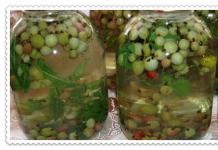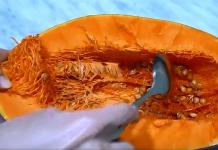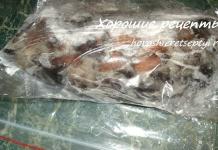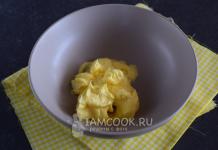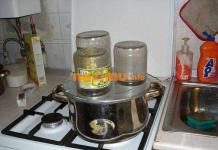Aloe and aloe vera are two different plants that, although they belong to the same genus, differ both in appearance, composition and application. The familiar aloe is a tree-like plant that is also referred to as "agave". Aloe vera is a herbaceous variety that does not form a tree-like stem, but its leafy plates grow from the root collar (rosette). Today we will consider what aloe vera is, how it is used, we will tell you about the benefits of the plant and the treatment of various ailments with its help.
Description and photo of the plant
The word "aloe" is of Arabic origin and means "bitter", which is quite logical, because the leaves of the plant contain bitter substances.
Botanical description
Scarlet present (second name) is an evergreen succulent herbaceous plant, which belongs to the asphodelic subfamily. It has a short stem, from which long, curved, fleshy leaves that look like the tentacles of an octopus extend. It is classified as succulent for the reason that leaf plates are able to store a lot of moisture, as well as prevent excessive evaporation.
 The rosette has a diameter of up to 60 cm. The rhizome is short, pivotal. During flowering, the aloe throws out a long arrow, on which tubular yellow flowers are formed.
The rosette has a diameter of up to 60 cm. The rhizome is short, pivotal. During flowering, the aloe throws out a long arrow, on which tubular yellow flowers are formed.
Spreading real aloe
The homeland of aloe vera is the southwestern regions of the Arabian Peninsula, it also grows on the African continent: mainly in North Africa and some territories in the west and east of the mainland. You can meet the plant in Portugal (on the island of Madeira) and in the Canary Islands.
What is included
The composition of the plant is impressive:
- esters and essential oils;
- organic acids (malic, citric, succinic);
- flavonoids;
- enzymes;
- minerals (over 30!);
- amino acids (threonine, methionine, leucine, lysine);
- Sahara;
- vitamins (group B, choline, folic acid, A, C, E);
- enzymes;
- anthraglycosides.
Did you know? The ancient Greeks knew about healing properties aloe as early as the 4th century BC. It is believed that it was for the sake of a useful plant that Alexander the Great seized, on the advice of Aristotle, the island of Socotra, where it grew in abundance.

Aloe-based products can:
- stimulate the production of collagen (a substance that is the basis of connective tissue, which performs a protective and supporting function in all organs in the body);
- have an antioxidant effect (remove free radicals that can cause cancer);
- remove toxic compounds from the body;
- strengthen the immune system;
- improve metabolism;
- accelerate tissue regeneration;
- slow down cell aging;
- destroy bacteria, including staphylococci and streptococci;
- relieve inflammation;
- relieve stomach and intestinal cramps;
- have a mild laxative effect.
The presence of such a number of useful properties is due to the rich balanced composition. A positive effect is achieved not only due to vitamins and trace elements, but also due to the presence of biologically active substances that stimulate the production of antibodies and compounds in the body that can improve protection, as well as destroy the pathogenic flora that causes the appearance of diseases.  The composition of the plant has not been fully investigated to this day, so it is impossible to say for sure which components make the plant under discussion indispensable in the treatment of diseases associated with the activity of microorganisms.
The composition of the plant has not been fully investigated to this day, so it is impossible to say for sure which components make the plant under discussion indispensable in the treatment of diseases associated with the activity of microorganisms.
Application features
The plant is so useful that some ailments are treated simply with its juice, which does not undergo any additional processing. Although, of course, there are various preparations based on the components of aloe vera.
Fresh juice
With the help of juice, the following diseases are treated:
- stomach ulcer;
- gastritis;
- dysentery;
- tuberculosis;
- purulent wounds;
- runny nose;
- acne;
- burns.

Tuberculosis. Mix equal parts of aloe vera juice and cuff, butter, honey and cocoa. Stir. Take 15 g in the morning and evening half an hour before meals.
Burns, suppuration. Cotton pads or tampons are moistened with concentrated juice and placed on the affected area. You need to change the lotions as it dries.
Runny nose. For the treatment of adults, take pure juice, for children - diluted 1 to 2 with water. 5-6 drops are instilled into each nostril, after which the head is slightly thrown back. The procedure is repeated three times a day.
Acne. If acne appears as a result of blockage and inflammation of the pores, then you need to wipe the affected areas daily with a small piece of freshly cut leaf, in which there is a lot of liquid. You must first degrease the skin with medical alcohol. The second option involves mixing white or blue clay with aloe juice. The gruel is applied to the face and kept for about 15 minutes.
Gel
It is a gel from the pulp of a plant, which is food additive... Note: it is an additive, not a drug.  Pharmachologic effect:
Pharmachologic effect:
- improves the functioning of the digestive system;
- removes toxic substances;
- destroys viruses, bacteria and fungi that cause diseases;
- improves the absorption of vitamins dissolved in water or fats;
- normalizes metabolism;
- normalizes the pH level at the cellular level;
- improves the functioning of the immune system;
- positively affects the recovery processes in the tissues of the pancreas.
Important! The supplement increases the threshold for sensitivity to allergens, so it can help relieve asthma symptoms.
The dosage is as follows: during the day, you need to drink from 40 to 120 mg of the supplement, having previously shaken it. If you experience a negative reaction from the body, be sure to consult a doctor. Do not exceed the dosage.  There are also cosmetic gels with aloe, in addition to the main component, they also contain others useful material, for example, allantoin, herbal extracts, vitamins. Such funds heal abrasions well, protect skin cells from oxidation, accelerate regeneration, maintain moisture balance in the skin, normalize the work of the sebaceous glands, and lighten age spots. There are no uniform rules for the use of gels - each manufacturer indicates recommendations on the packaging or leaflet.
There are also cosmetic gels with aloe, in addition to the main component, they also contain others useful material, for example, allantoin, herbal extracts, vitamins. Such funds heal abrasions well, protect skin cells from oxidation, accelerate regeneration, maintain moisture balance in the skin, normalize the work of the sebaceous glands, and lighten age spots. There are no uniform rules for the use of gels - each manufacturer indicates recommendations on the packaging or leaflet.
Extract
The concentrated aloe vera extract is sold as a solution for injection (1 ml ampoules). With its help, such ailments are treated:
- myopia;
- myopic chorioretinitis;
- blepharitis;
- conjunctivitis;
- ulcers of the stomach and duodenum;
- iritis (a disorder of the iris);
- keratitis.
 The contents of the ampoule are injected into soft tissues 1 ml at a time for adults (the maximum daily dose is 40 ml) or no more than 0.5 ml at a time for children over 5 years old. The treatment course is from 30 to 50 injections. It is used for children from 4 years old.
The contents of the ampoule are injected into soft tissues 1 ml at a time for adults (the maximum daily dose is 40 ml) or no more than 0.5 ml at a time for children over 5 years old. The treatment course is from 30 to 50 injections. It is used for children from 4 years old. Important! The remedy enhances the effect of iron-containing drugs and can cause potassium deficiency when taking diuretics.
Ointments
The ointment is made from aloe juice. For this, juice and honey are mixed in equal parts. A tablespoon of alcohol is added to a glass of the mixture. Everything is mixed and stored in the refrigerator.
A remedy is used to treat wounds and ulcers. A bandage can be applied over the ointment applied to the affected area. Treatment is carried out until complete recovery.
Contraindications and possible harm
It is forbidden to use aloe:
- during pregnancy;
- during breastfeeding;
- in the presence of chronic heart disease;
- people with severe liver or kidney disease;
- in the presence of allergies;
- with severe depletion of the body.
 Caution should be exercised in such cases:
Caution should be exercised in such cases:
- if there is a hypersensitivity to antibiotics;
- when taking vitamin complexes, so as not to cause hypervitaminosis;
- with increased acidity or hypersensitivity of the stomach.
Did you know? The Egyptians considered aloe a plant of immortality, and its juice was used both for treatment and for embalming.
Aloe vera, although a relative of the agave, is slightly different in properties and uses. It is a wonderful herb that can help solve many health problems without the use of chemicals or drugs that are aggressive to the internal environment.
After analyzing medicinal properties and contraindications of aloe vera, it is possible to obtain several effective dosage forms that help accelerate the treatment of a number of diseases.
The difference between aloe vera and aloe tree
The genus Aloe from the Asphodeloid family unites about five hundred species that are succulents. The most popular and famous is aloe tree (agave) and present ( faith). They are close in chemical composition. They are widely used in cosmetology and medical practice.
To understand how aloe differs from aloe vera, you need to consider their appearance:
- A powerful trunk is formed at the agave. Juicy elongated leaves extend from it. Under natural conditions ( Zimbabwe Territory, Mozambique) the tree reaches a height of 3 m.
- Aloe vera is a herbaceous variety. Leaf plates - wide and lush, rise directly from the root collar, forming a rosette.
How can aloe help? Video:
Homemade aloe Vera flower: benefits and harms
Plants - succulents accumulate and retain moisture in the fleshy leaf plates. This explains their unpretentiousness and the ability to endure periods of drought.
For traditional medicine, the home flower of aloe vera, the benefits and harms of which are well known, is a unique source for the preparation of medicines.
Used as raw materials succulent leaves, which include the following elements:

The rich structural formula of the plant has led to its beneficial characteristics:
- stimulation of the regeneration of collagen, which serves as the basis of connective tissue;
- antioxidant effect, promoting the elimination of dangerous free radicals;
- strengthening the immune system;
- normalization of metabolic processes;
- slowing down the aging of cells;
- providing antifungal, antibacterial, anti-inflammatory, antiseptic action;
- stimulating blood circulation.
The antiviral effect is provided due to the presence of acemannan in the composition. This element helps to activate the defense mechanism designed to destroy foreign harmful cells, including malignant tumors.
Contained in aloe vera ulcin, which prevents the development of ulcerative pathology. The laxative effect is due to the presence of the aloin element.
Quickly heals skin lesions - wounds, burns.
Medicinal formulations based on aloe vera are used for the following diseases:
- arthritis;
- gastritis;
- stomach ulcer;
- pulmonary pathology;
- cold;
- sinusitis;
- throat ailments.
Contraindications:
To avoid unwanted side effects, it is necessary to observe the dosages recommended in the recipes for preparing and taking a variety of products based on aloe vera.
Applying fresh juice
To get the healing juice of aloe vera, cut a fleshy leaf near the base of at least three years of age.
Before the procedure, the flower is not watered for two weeks.
Raw materials are washed thoroughly under running water. Finely chopped or turned into gruel using a blender. Squeeze the juice through a double gauze pad.
Take only fresh extract 30 minutes before meals, 1 tsp. without drinking water. The result is relief from tuberculosis, I stomach ulcer... The technique is used to treat dysentery and gastritis.
When applied externally, aloe juice heals burns, purulent wounds, and eliminates acne.
With a runny nose, 3 drops are injected into each nostril three times a day. Due to the anti-inflammatory effect, rinsing with an aqueous solution ( 1:1 ) sore throat.
Other dosage forms
Aloe vera is used as a raw material for the preparation of home remedies, which are popular due to their high effectiveness. It is important to observe the regularity of the procedures.
When preparing the compositions, glass or ceramic dishes are used. All additional ingredients must be of good quality.

Ointment
After thoroughly washing the aloe leaf, it is chopped and squeezed out. Measure 100 ml of the resulting liquid, mix with the same volume of honey, which, if necessary, is slightly warmed to a fluid state in a water bath.
With stirring, introduce 1 tbsp. l. alcohol. Pour into a glass bottle with a tight lid, which is placed in a refrigerator.
Lubricate the skin to treat ulcers and wounds.

Decoction
It relieves inflammation of the mucous membranes, healing. The washed and chopped leaves are rubbed with a wooden spoon.
Transfer to an enamel pan. Pour in water ( 1:5 ). Boil for 2 minutes and filter after cooling.

Tincture
To prepare an effective tincture, it is recommended to keep the cut and washed leaves in the refrigerator for 12 days, wrapped in a thin cloth.
Then they are cut into small pieces and put in a glass jar. Pour in vodka, keeping the ratio 1:10.
It is kept in the dark for 7 days, and then filtered into a darkened glass vessel.
Store under a sealed lid in a cool environment.
In order to increase immunity, take 1 tsp 30 minutes before breakfast, lunch, dinner. Do with tincture lotions for ulcers, wounds, wipe acne. Used to rinse the mouth with stomatitis.

Butter
You can buy at the pharmacy or, if necessary, make your own aloe Vera oil, the properties and uses of which are widely known.
Thanks to its wound healing, regenerating, anti-inflammatory, antiseptic qualities, a good effect is observed in the treatment of eczema, wounds, acne, and burns.
At home cooking take leaves previously kept in the refrigerator for 12 days.
Cut them lengthwise and separate the pulp with a wooden spatula. Placed in a glass jar. Add cold-pressed sunflower or olive oil in a 1: 9 ratio.
Place under the lid in a dark cabinet for 2 weeks, shaking after 2 days. After filtration, a vitamin E capsule is introduced. In a glass bottle under a tight stopper, keep in the dark and cool.
Aloe Treatment with Honey. How to prepare and how to take. Video:
Folk recipes
Homemade aloe products are used for various diseases... They usually become an adjunct to drug therapy, allowing for faster recovery.
Popular recipe options:
1. Tuberculosis. Combine the juice obtained from the leaves of aloe and the cuff with the addition of honey, softened butter and cocoa powder.
The ingredients are taken in equal volume fractions and mixed thoroughly. Eat before breakfast and dinner - 30 minutes in advance for 1 tsp.
2. Indigestion. Aloe juice - 300 ml, liquefied with slight heating - 500 ml and red wine - 700 ml are poured into sterile glassware.
They are kept in the dark for five days. After filtration, use three times a day for 1 tbsp. l. before eating.
3. Constipation. The leaves of the plant are washed and finely chopped. Measure out 150 g, mix with liquid honey - 300 g, insist for a day.
Then it is slightly warmed up with a water bath and filtered. It is recommended to take in the morning on an empty stomach before breakfast - one hour for 1 tsp.

4. Laryngitis, bronchial asthma, peptic ulcer. Combine half a tablespoon of honey and aloe juice. Dissolve the mixture in boiled milk cooled to a warm state.
This serving is consumed daily 30 minutes before breakfast, lunch and dinner. After 3 weeks, take a break for 14 days and, if necessary, repeat the course.
5. Heart attack. Washed dried fruits - 3 tbsp. l. - placed in an enamel bowl. Pour in half a glass of boiling water.
Cover with a terry towel. An hour later, drain the infusion and add aloe juice to it - 2 tbsp. l.
Throughout the day, they drink the healing liquid in small sips.
6. Heartburn. Calamus root is crushed. Measure 1 tbsp. l. and placed in an enamel cup. Add boiling water - 300 ml, cover with a towel. After 20 minutes, the composition is heated for 10 minutes using a water bath.
Squeezed aloe juice is added to the cooled and filtered broth - 0.5 tbsp. l. Eat before breakfast and dinner - for half an hour, 1 tbsp. l. The course is 2 weeks.
Cosmetological effect
At home, masks are prepared to eliminate fine age wrinkles, even out and improve the complexion, and make the skin fresher and younger.
To effectively use aloe vera for the face, you should mix the ingredients for cosmetic products without the use of metal utensils from quality ingredients.
1. In order to improve skin color fresh aloe juice in equal proportions is combined with cream. Withstands the mask for 20 minutes and remove with warm water.
2. Beaten egg white can help reduce the greasy shine. into which the pulp of aloe leaves is introduced - 1 tsp. This mixture is applied to the skin of the face in a thick layer, holding for 15 minutes.

3. Acne mask is popular. For her, a piece of a plant leaf is cut off, washed, finely chopped, cutting off sharp thorns beforehand.
Rub with a wooden spoon, gradually introducing honey in equal parts. Distribute the mass over the cleansed face. Hold for 20 minutes and wash off.
4. Another recipe can be used to combat acne. The skin is preliminarily defatted with medical alcohol, and then treated with a piece of a sheet cut along the central longitudinal line.
Insist under a napkin for 15 minutes. Spread over the skin and wash off after 30 minutes. This procedure can be repeated every other day.
Aloe vera, with the proper use of its amazing properties, becomes a home medicine cabinet. It is important not to weaken the plant, cutting off only part of the leaf, if necessary, if you need to treat a wound or wipe a problem area of the skin.
With a careful attitude, the plant will develop well and will not die.
You need to enable JavaScript to voteOnce upon a time, aloe, or among the common people the agave, was the most widespread houseplant. The flower is an indispensable ingredient for traditional medicine and home cosmetics. The plant does not require much attention, but you should remember some of the nuances: what is the care of aloe vera, take into account its medicinal properties and contraindications for use.
Aloe is native to the southern regions of Africa
Aloe belongs to succulents, maybe long time do without watering, but still requires compliance with certain conditions. What you should pay attention to:
- Light. The plant loves light, so it is better to place it on the south side, and in winter it should be additionally illuminated with lamps. If this is not possible, it is recommended to put the container with aloe in a well-lit place.
- The soil. The substrate in a flower pot should be fertile, loose, with good air permeability. You can buy it in a store or prepare it yourself by mixing turf, sand, charcoal and expanded clay for drainage.
- Temperature and humidity. Unlike many others indoor plants, the agave tolerates temperature extremes well. In summer, the optimum temperature for a flower is 20–26 ° C, in winter, no more than 15–17 ° C. The succulent is unpretentious to humidity, so its leaves should be sprayed and wiped only to remove dust.
- Watering. The frequency of watering in the warm season is 1-2 times a week, in winter it should be reduced to once a month. Water the plant with settled water at room temperature so that the soil is saturated, and then drain the liquid that remains in the pan. It is important to remember that overflow for aloe is worse than underfilling - from an excess of liquid, the leaves stretch out and lose their decorative characteristics, and the roots can rot.
- Top dressing. The flower should be fed with special fertilizers for succulents and cacti. The procedure is carried out from April to September every three weeks, the feeding should be diluted as indicated in the instructions.
- Transplant. Young plants are transplanted every year, adults - every 2-3 years. For aloe, you need to choose deep containers and remember the necessary characteristics of the substrate.
Aloe is resistant to diseases and pests, but sometimes harmful insects (spider mites, scale insects and others) can take a fancy to the flower. To prevent infection, wipe the leaves with soapy water.
The healing properties of aloe vera
 Despite the long-term medical practice with the use of aloe, its composition is not fully understood.
Despite the long-term medical practice with the use of aloe, its composition is not fully understood. Along with the tree-like variety of the aloe vera culture, it is widely used in medicine for the preparation of remedies and the treatment of various diseases. The plant contains about 30 vitamins and microelements necessary for the body, as well as amino acids and bioactive substances. Due to its unique composition, it has the following beneficial properties:
- removes toxins from the body, eliminates the negative effect of free radicals;
- cleans the blood, improves its composition and basic indicators, lowers cholesterol levels;
- destroys pathogenic microorganisms, including streptococci, staphylococci, Escherichia coli;
- has anti-inflammatory and analgesic effects;
- strengthens the immune system and increases the body's resistance;
- normalizes the digestive tract;
- activates metabolic processes;
- promotes tissue regeneration and wound healing.
Aloe juice and products with its addition are used for the treatment of neurological, gynecological and ophthalmological diseases, disorders of the digestive tract, cardiovascular and urinary systems.
In cosmetology, the plant is widely used due to its unique moisturizing properties. A substance called allatonin, which is included in its composition, retains moisture in the depths of tissues, promotes skin rejuvenation and slows down age changes.
You can buy aloe vera juice at a pharmacy or make your own. To do this, you need to take a fleshy leaf of a plant that is at least three years old, wrap it in paper and put it in the refrigerator for several weeks. After that, grind the sheet, squeeze the juice out of it and use it for the preparation of cosmetic products.
Face recipes
 For long-term storage of aloe, you can use recipes for tinctures on alcohol
For long-term storage of aloe, you can use recipes for tinctures on alcohol For skin care, aloe vera can be used in a variety of ways. The easiest way is to add a little juice to toners, creams, and other products, or apply it to a cotton pad and wipe your face regularly. In addition, there are many recipes for masks that take good care of the skin, eliminate blemishes and smooth wrinkles.
Universal mask
The product smoothes the skin and gives it a healthy, radiant appearance. What do you need:
- Take egg yolk, a teaspoon of sour cream and the same amount of juice or aloe extract.
- Mix all the components and apply on the face and neck with a brush in layers, and each layer must be allowed to dry first.
- Keep the mask for 20 minutes, then rinse with warm water and wash with cool.
The mask is suitable for any type of skin; if the dermis tends to be greasy, it is better to take fat-free sour cream or cottage cheese.
Vitamin
The mask will help eliminate signs of wilting, reduce oily skin and tighten pores. How to prepare and apply:
- Mix a teaspoon of honey and castor oil, half a teaspoon each lemon juice and aloe extract, one yolk.
- Mix everything, add chickpea flour or chopped on a coffee grinder cereals- you should get a mushy mass.
- Apply on face and neck for 20 minutes, then wash with warm and cool water alternately.
Mask for problem skin
 Aloe tincture is widely used in the treatment of colpitis and erosion of the cervix: the agent is diluted in water and irrigates the vaginal mucosa
Aloe tincture is widely used in the treatment of colpitis and erosion of the cervix: the agent is diluted in water and irrigates the vaginal mucosa To prepare such a mask, you need:
- Cut aloe leaf into pieces, pour 400 ml of water, put on fire.
- After boiling, let cool, strain and mix with 4 tablespoons. honey.
- Cool if necessary, apply on face for 10 minutes.
The tool has antibacterial and anti-inflammatory effects and allows you to forget about acne and rashes for a long time. It is recommended to use it at least twice a week.
An allergy test is recommended before using any of the aloe products. Apply a small amount of pure plant juice or a mixture with its content to the inner surface of the elbow, leave for 10-15 minutes and wait for the reaction. If rash, inflammation, and itching are absent, the product can be used to care for your skin.
How to use the plant for the stomach
Aloe juice effectively treats gastritis, colitis, gastric ulcers and other gastrointestinal diseases. It has an anti-inflammatory effect on the mucous membranes, promotes their regeneration, activates the secretion of the glands and improves the functioning of the digestive system. Options for using aloe:
- For severe abdominal pain, the following medicine can be prepared. Grind several prepared aloe vera leaves (they must first be kept in the refrigerator for a couple of weeks), add water in a ratio of 1 to 3 for 1.5 hours, filter and squeeze out the juice. For 100 g of liquid, take 500 g of honey and 300 g of walnuts, mix well, take 1 tablespoon each. three times a day half an hour before meals.
- Most effective remedy from ulcerative lesions of the mucous membranes, gastritis and other gastrointestinal diseases: take 400 g of aloe juice, add 600 g of honey and the same amount of homemade red wine or Cahors. Pour the mixture into a glass container, mix well and refrigerate for 3-5 days. Drink 1 tbsp. three times a day on an empty stomach or one hour before meals. After taking the product, it is recommended to eat a piece of butter.
- Chronic gastritis is treated with honey, carrot juice and aloe. Mix 100 g of bee product and aloe juice in a separate container, pour in 2 tbsp. freshly squeezed carrot juice, mix again. The remedy is taken on an empty stomach, 1 tbsp. three times a day in a course of one month.
- If gastrointestinal diseases are accompanied by constant constipation, you need to: take 150 g of crushed aloe leaves, mix with 300 g of liquid honey, leave for a day, then warm and filter. The medicine should be taken in the morning one hour before a meal, one spoonful.
Where else is the plant used
 Aloe leaves are rich in the Aloe-M1 component, which has high regenerative properties and inhibits the growth of cancer cells
Aloe leaves are rich in the Aloe-M1 component, which has high regenerative properties and inhibits the growth of cancer cells Aloe juice diluted with water can also be used for the following purposes:
- bury your eyes at infectious diseases and in the nasal passages with a cold, sinusitis, sinusitis;
- for washing and douching for gynecological diseases and inflammatory processes;
- treat wounds, burns and other skin injuries, treat boils, psoriasis, dermatitis and eczema;
- gargle with sore throat, mouth with gingivitis, periodontal disease, toothache;
- taken orally with a decrease in immunity and frequent colds;
- rub into the scalp to eliminate baldness, dandruff and dry skin;
- use for disruptions to work nervous system, insomnia, frequent stress;
- used as part of complex therapy for the treatment of disorders of the kidneys, pancreas and biliary tract, tuberculosis, benign and malignant tumors.
In small doses, aloe juice can be used to treat and prevent any disease. It is important to observe the dosage and the rules for preparing medicines from the plant, monitor the body's reaction, and consult a doctor before using.
Contraindications
 Aloe contraindications do not apply to external use, as they are completely safe.
Aloe contraindications do not apply to external use, as they are completely safe. Like any other drug, aloe has a number of contraindications, which include:
- pregnancy and lactation;
- individual intolerance to plant components;
- persistent pressure increase;
- open wounds and bleeding;
- menstruation in women, especially if the cycle is irregular and the discharge is abundant;
- acute heart failure;
- age up to 1 year (if there is a tendency to allergies up to 3 years).
Aloe vera is a unique plant that will not only decorate the room, but also help maintain the health of the whole family. When used correctly, it effectively treats almost all diseases, strengthens the body, enhances immunity, and helps to maintain youth and beauty.
Aloe vera and aloe tree are very similar in appearance and have similar medicinal properties. Both of these plants are often home grown and used for skin care or medicinal purposes.
Aloe is an unpretentious perennial with fleshy green xiphoid leaves. The leaves form a large rosette or are located on a thick trunk (aloe tree). There are small sharp thorns along the edges of the leaf plate, with the help of which the plant evaporates water.
Aloe vera leaf contains a transparent gel-like pulp, which is of interest as a medicinal raw material. Aloe blooms during the winter months and is very rare, releasing a long peduncle with a cluster of white, orange or red flowers.
The plant comes from countries with hot climates, so it prefers an abundance of sunlight and minimal watering. Medicinal properties aloe is actively used in folk medicine as well as in the pharmaceutical and cosmetic industry.
Procurement of raw materials
For the manufacture of drugs Requires the juice and pulp of the leaves of the plant at least five years of age. Before harvesting raw materials, aloe is not watered for two weeks.
Select thick fleshy leaves from the lower and middle tiers, gently break off and wash with cool water. After drying the leaves, they are wrapped in paper, leaving the ends free, and placed in a cool place for 10 days. Usually a refrigerator is used for this.
In the future, the leaves are crushed into small pieces and poured over for two hours. cold water... Squeeze the mass and use immediately or store the juice in a tightly closed glass container in the refrigerator for several days.
The healing properties of aloe vera
V chemical composition aloe includes:
- phenols and steroid substances;
- anthraglycosides and enzymes;
- flavonoids and tannins;
- essential oil and amino acids;
- glucose, fructose, gum and bitterness;
- polysaccharides and carotene;
- organic acids (succinic, citric, hyaluronic, salicylic, malic, cinnamic);
- ascorbic acid and B vitamins;
- vitamins E and A;
- micro and macro elements (iron, zinc, chromium, phosphorus, magnesium, calcium, calcium).
The medicinal properties of the plant include:
- reduces pain and soothes irritation;
- stimulates the production of bile and lowers glucose levels;
- inhibits the development of bacteria, viruses and fungi;
- regenerates and heals wounds;
- relieves inflammation;
- has a laxative, anti-allergenic and antioxidant effect;
- inhibits the growth of tumors and prevents the formation of malignant neoplasms.
Aloe normalizes metabolic processes and cleanses the body of toxic substances, tones up and improves immunity, removes excess cholesterol and rejuvenates.
Indications for use

Aloe is used for such diseases:
- Respiratory pathology. It is used to treat viral and colds, as an antibacterial and antiseptic for angina, sinusitis, flu. Relieves cough with bronchitis, tuberculosis, pneumonia. Aloe helps to get rid of a runny nose and sore throat, is effective in bronchial asthma.
- Diseases of the digestive system. It is used for constipation, chronic pathologies of the gallbladder and pancreas. With the help of aloe, colitis, stomach ulcers, pancreatitis and chronic gastritis are treated.
- Cleans the blood and blood vessels from cholesterol, normalizes lipid and carbohydrate metabolism, removes toxins and cleans the bile ducts. This makes the herb useful for weight loss and endocrine disorders.
- Aloe increases appetite and tones, relieves joint inflammation and relieves pain. It is used for diseases of the oral cavity and gynecological diseases (thrush, cervical erosion, stomatitis).
It is especially popular as a wound healing and antibacterial agent for eczema, acne, psoriasis, burns, cracks, wounds and cuts. It is used to treat trophic ulcers, herpes and lupus.
Aloe vera is actively used for skin and hair care. Moisturizes and nourishes the epidermis, smoothes wrinkles, tones and relieves irritation.
Contraindications
However, not everyone and not always can be treated with aloe.
It is forbidden to take plant-based drugs in the following cases:
- period of bearing the child;
- the menstrual cycle and any internal bleeding;
- age less than 3 years;
- hypertension
- cystitis and kidney disease;
- exacerbation of chronic diseases;
- pathology of the cardiovascular system;
- intestinal obstruction;
- digestive disorders;
- haemorrhoids;
- increased susceptibility to the components of the composition.
Exceeding the dose of plant juice when taken internally can cause intoxication of the body and lead to the appearance of diarrhea, blood in feces and urine.
Do not ingest the leaves of the plant together with the skin. Long-term consumption of aloe peel can lead to the development of malignant tumors.
Pharmacy preparations
In pharmacy chains, aloe is widely represented in the form of various dosage forms:
- Syrup - liquid preparation containing iron. It is used as a laxative, tonic, choleretic and antiseptic. Designed for the treatment of iron deficiency anemia.
- Extract - the preparation is intended for injection. It is used in the treatment of eye diseases, pathologies of the bronchopulmonary and digestive systems. It is useful in the recovery period after a stroke, with male infertility, for the treatment of neuralgia.
- Tablets - are used to stimulate the regeneration function, as well as in case of visual impairment.
- Liniment aloe is a preparation for external use. It is applied to the affected areas of the skin with lichen, eczema, burns and dermatitis. It is also used to treat atrophy of the vaginal mucosa.
- Aloe juice is an alcohol-containing product for indoor and outdoor use. It is used as a bactericidal, tonic and laxative agent.
There is a rich assortment cosmetics with the addition of aloe. The plant extract is added to shampoos, deodorants, lotions, tonics, creams and facial cleansers.
Home use
For medicinal purposes, aloe juice is used. You can use it yourself or prepare an ointment, decoction or alcoholic infusion based on it.
Aloe-based preparations are an excellent external remedy that accelerates the healing of wounds, burns, eczema. They relieve inflammation and disinfect when rinsing the throat and mouth or when rinsing the nasal passages with a runny nose and sinusitis.
Decoction and tincture are no less effective for the treatment of cough, diseases of the digestive and bronchopulmonary systems.
Decoction
Boil 250 ml of water and add 10 g each of oregano, chamomile flowers, elderberry and linden. Insist for 30 minutes and add 20 g of aloe leaf gruel. Drink 100 ml during the day to relieve cough and sore throat. You can use the decoction to rinse the throat and mouth, and to rinse the nasal passages.
Juice
The juice is squeezed out of the biostimulated leaves after they have been refrigerated for 10 days. It is used in pure form or mixed with other components.
It is used in case of a tendency to frequent colds or flu, for the treatment of stomach ulcers, colitis, gastritis, bronchitis and pancreatitis. Juice is also suitable as a laxative. Take it in the morning, afternoon and evening for 1 tsp.
When used externally for the treatment of eyes and mucous membranes, the juice must be diluted with boiled water, for 1 tsp. juice - 10 tsp. water. Undiluted juice can only be used to lubricate wounds.
Aloe with honey
Mix 100 g of honey with the same amount of plant juice and drink 1 tbsp each half an hour before breakfast, lunch and dinner. l. for colds and viral diseases, for gastritis with low acidity, for the treatment of cough and increasing immunity. Store the drug for 30 days in a cool place. It can be used to treat cervical erosion by wetting a tampon and inserting it into the vagina, and also used for compresses and lotions for skin damage.
Ointment
The ointment is used for rubbing the chest when coughing, as well as for treating burns, difficult-to-heal ulcers and festering wounds. To prepare the drug, you will need ghee or melted pork fat and juice from aloe leaves.
Combine 200 g of fat, 150 ml of juice and 100 g of honey. Heat the mixture, stirring, until a homogeneous mass is formed and store in a cool place in a glass jar.
Tincture
Pour 500 ml of vodka into a jar and add 100 g of leaf gruel. 10 days to insist and drink before each meal in a large spoon.
In its pure form, it is used for lotions and treatment of skin lesions (except for burns), and in diluted form, it is used to wipe the skin of the face to treat acne and inflamed acne.
Aloe vera for women
Aloe is used for erosion and dysplasia of the cervix, helps to cope with candidiasis and inflammation of the vaginal mucosa. With difficulties with conception and genital infections, you can also seek help from this powerful antibacterial and immunostimulating agent.
For these purposes, aloe tincture is useful. Mix 50 g of honey with 2 tbsp. l. gruel from leaves. With a glass of boiling water, brew 20 g of dry St. John's wort and simmer over low heat for three minutes. Cool and mix with honey mixture. Add a bottle of dry white wine and leave for 10 days. Drink 2 tbsp before breakfast. l. in two weeks.
Soak a gauze swab with freshly squeezed aloe juice and insert into the vagina for a couple of hours in case of cervical erosion.
Mix 50 ml of olive oil with 50 g of goose fat and add 100 g of chopped aloe leaves. Put in the refrigerator for a week. In the morning, afternoon and evening, dilute 1 tbsp. l. mixture in 250 ml of hot milk and take with or without food. This is a fertility cure.
Use in cosmetology
The rejuvenating and moisturizing properties of aloe have been successfully used in facial skin care, and it can also help get rid of acne and acne.
Smoothing wrinkles and soothing irritated skin will help daily "driving" fresh aloe juice into the skin of the face. Repeat for 10-14 days.
Mix 1 yolk with 1 tbsp. l. sour cream and a teaspoon of aloe juice. Spread on the skin of the neck and face, after a couple of minutes apply a second layer and repeat this several times. After half an hour, wash off the mask. Repeat every 7 days. The skin is smoothed, its tone is increased and the complexion improves.
In two glasses of water, boil 20 g of aloe for 10 minutes and moisten the hair roots and scalp with the broth. This will help strengthen the hair follicles and stop hair loss.
Aloe feels great on the windowsill and does not cause any particular difficulties in care, only you need to be careful about watering. But there will always be at hand a proven remedy for a cold, colds or viral diseases, abrasions and cuts. And if you regularly wipe your face with an aloe leaf, after removing the skin from it, then the skin will become fresh, moisturized and toned.
2017-12-02T17: 01: 06 + 00: 00
I have Small child(2.8 years) is constantly sick with colds. At the next call to the pediatrician at home, I asked if it was possible to drip 1-2 drops of aloe juice into the nose. The pediatrician's answer surprised me: she replied that small children should not be instilled with aloe juice, as the vessels in the nose can burst from her words. how true is her statement?
 To date, there are about five hundred varieties of aloe. However, only two types are considered the most popular and in demand.
To date, there are about five hundred varieties of aloe. However, only two types are considered the most popular and in demand.
Aloe vera (agave) and tree aloe (agave) are actually the same plant, differing from each other in appearance.
So, the agave has a thick trunk, from which juicy leaves grow. Agave has the shape of a bush, in which lush, wide leaves that tend upwards grow from the very base. The chemical composition and medicinal properties of both plants are the same.
The very first mention of aloe was found on Egyptian papyrus in the fifteen hundredth year BC. This "discoverer" was the German writer and physician Georg Ebers.
It is thanks to him that aloe has become a permanent inhabitant of every modern home. This wonderful plant has become a lifesaver for the treatment of various diseases. 
The chemical composition contains many useful trace elements to improve the functioning of internal and external organs.
Aloe is saturated with a whole complex of vitamins: C, E, A, B1, B2, B6, B9 and B12. It also contains minerals: potassium, selenium, calcium, copper, chromium and sodium.
In addition, this miracle of the plant has a detrimental effect on streptococci, dysentery and Escherichia coli.
Mono- and polysaccharides, antioxidants, salicylic acid, amino acids and enzymes - all this list of substances contains this wonderful plant.
Aloe can be squeezed into juice and pulp. Before you pluck a leaf, pay attention only to the lowest and thickest leaves that have a dry tip.
This is a sure sign that the leaf has absorbed all the most useful substances and can be cut off. Before starting up aloe for medicinal purposes, it must be put in the refrigerator for a week, and then rinsed with warm boiled water.
It is not difficult to get the pulp from the plant, just carefully cut off the green skin with a knife and you will have a product ready to use.
 Useful properties and application of the agave
Useful properties and application of the agave
Now it is worth taking a closer look at the beneficial properties of the agave and its scope. This type of plant is great for:
1) get rid of boils and draw out pus;
2) soothe the irritated area with insect bites;
3) heal wounds and cuts;
4) restore hair follicles and enhance hair growth, as well as get rid of dandruff;
5) improve complexion and smooth out wrinkles;
6) get rid of varicose veins;
7) heal ulcers and eczema, as well as ease the course of psoriasis;
Useful properties and uses of aloe vera
Agave, like the agave, has the same chemical composition, however, according to doctors, its juice and pulp are best used for internal use.
Its beneficial properties are able to work wonders and have a beneficial effect on the body according to such criteria as:
1) strengthening the cardiovascular system;
2) restoration of the gums;
3) improvement of the function of the urinary tract;
4) strengthening the body's immune system;
5) regulation of the amount of sugar in the blood;
6) prevents the occurrence of heartburn and digestive disorders;
7) reduces pain and inflammation in arthritis.
Aloe vera, like the agave, despite its invaluable benefits, have some contraindications for use. So, aloe vera is contraindicated for the following problems and violations:
- diabetes;
- disruption of the blood vessels;
- consistently low blood pressure(hypotension);
- pregnancy.
The centenary is contraindicated only in oncology, since the enzymes included in its composition accelerate the growth of cells. For those who have benign or malignant tumors, this plant can cause them to develop.
The conclusion is quite simple, agave and aloe vera plants are as similar to each other as possible. The few differences between them are external factors, areas of application and contraindications.
It is simply necessary to grow these types of aloe in your home. In addition to the fact that this plant is not whimsical, it will become your home doctor and assistant in the fight for health more than once. Aloe Vera or Agave? The choice is only yours!
Make a start from your needs and be sure to get this plant at your home pharmacy.




















